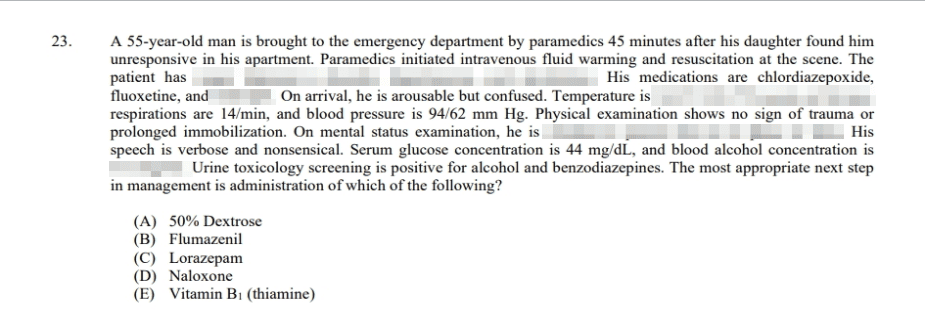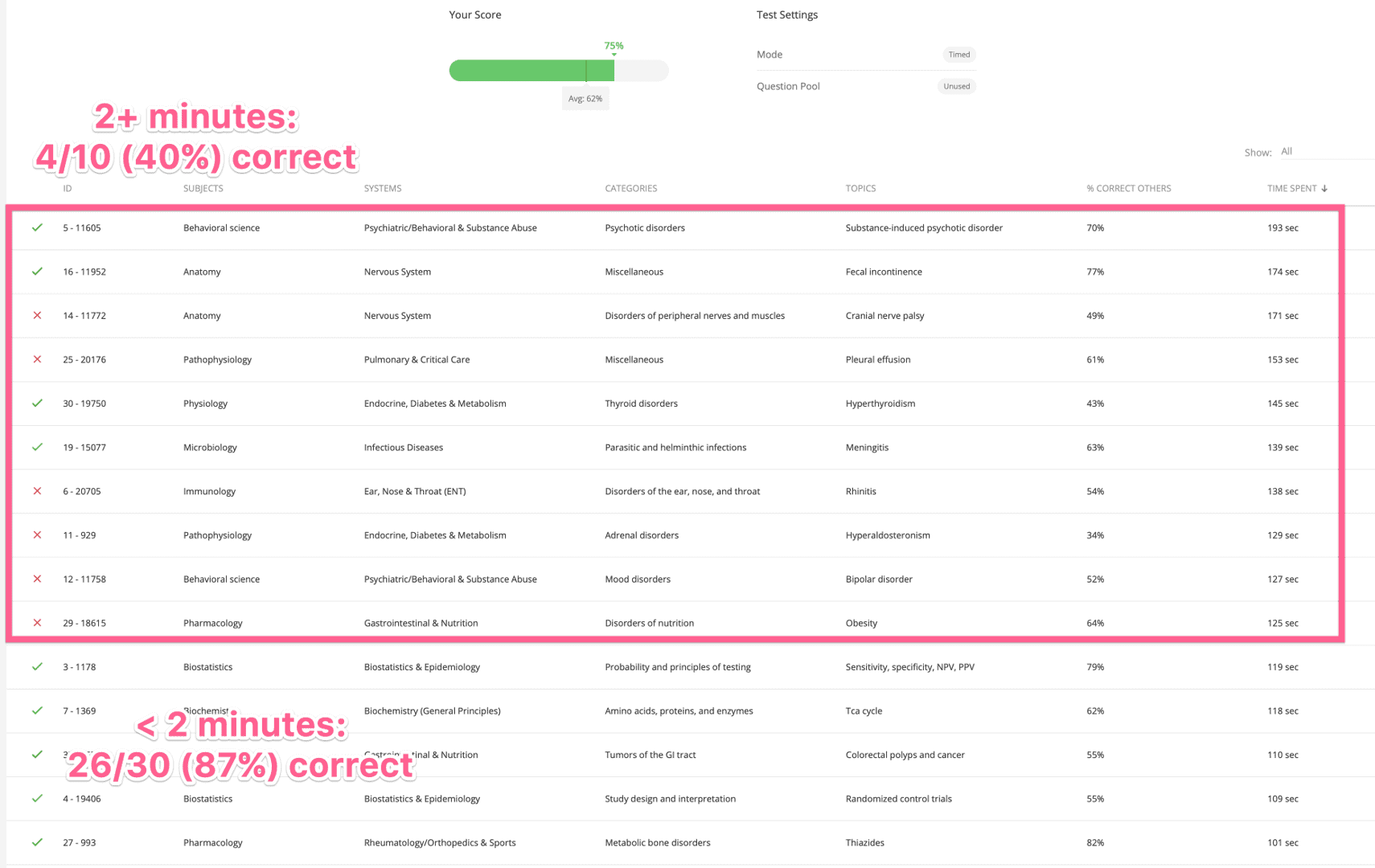
Do you find yourself rushing to finish your question block? Are you concerned you’re a slow reader? Are you glancing anxiously at the timer tick? Do you miss questions because you had to rush through them? Are you trying to improve your score quickly? If so, you may be struggling with timing on the USMLE Step 1, Step 2 CK, or Step 3.
I’ve tutored hundreds of students individually. By overcoming their timing struggles, many of them improved their scores and approached their tests more calmly.
In this article, you will learn:
-
- The #1 reason why most people run out of time on the USMLEs
- Why even slow readers like myself can end a block with 5-10 minutes left
- The counterintuitive technique you can do to get extra time on each question immediately
- How you can track your improvements in the quality of your reading, and
- Much more
Table of Contents
1. Take the Time to Master Material the First Time
How often do you read a sentence in a vignette and not know what it means? If you’re like most of us, the signs/symptoms on USMLE vignettes can be bewildering. Mottled skin. Harsh systolic murmurs. Hydrophonic nasal voice. Descriptions often seem (or are) different than what we studied. The NBME test-writers use precise language, but it can sometimes feel like they’re intentionally trying to confuse us.
So what are you supposed to do when you see a passage you don’t understand? First, do your best to answer the question. Then, once the block is over, fight the urge to skim through the explanations. Instead, slow down, back up, and take the time to understand everything in the vignette. Identify the critical points where you lack understanding.
The #1 issue behind timing issues isn’t our slow reading speed or the length of the vignettes. Instead, if we are processing the vignette too slowly, it is because we haven’t learned it well.
What do I mean? On the day of your test, for every sentence you read, one of two things will be true:
- You had processed/made sense of that information beforehand, or
- You rushed through and/or weren’t able to make sense of it
If you don’t know what a “flapping tremor” meant for that cirrhotic patient on your QBank, it won’t suddenly make sense on test day. So instead, take 5 minutes to figure out what that sign means. Every time you do so, you will save Future You time from having to ponder what each clinical clue means.
2. Read Slowly (Yes, You Read That Correctly)
But what if you know the material well? Or even if you haven’t mastered everything, is there something you can do to get more USMLE questions correct?
You can – you need to read more slowly. Yes, you read that correctly.
For a long time, I assumed that by reading faster, I would finish with more time. However, I found the opposite to be true. Why?
For most of us, the faster we read, the less we comprehend. And one key to having more time on your test is to make sure you don’t have to re-read anything. Like most standardized exams, you have enough time to read every question on the USMLE slowly. (Yes, even the extended vignettes!) However, you do NOT have enough time to read every question twice quickly.
The faster we read, the more likely it is that we’ll miss something important and thus:
1) Get the question wrong and/or
2) Waste time unnecessarily reading through the vignette again
Next time you do a block, count the number of times you have to re-read a question. Remember that your overall timing will be slower every time you do so – no matter how fast your eyes move across the vignette.
3. Address Test-Taking Anxiety
Another huge issue with people needing to re-read questions is high anxiety. Anxiety causes us to speed up and further reduces our ability to understand what we are reading.
When we read a vignette while feeling anxious, it is like taking white-out to the screen. Instead of having every clue to work with, it is like reading a heavily redacted document.

The more anxious we feel, the less we comprehend of what we read. It’s like taking white-out to the screen.
Dealing with test-taking anxiety is a massive discussion in itself. The crucial initial step is to recognize that anxiety doesn’t exist in a vacuum. There are many reasons why you are anxious. Identifying those reasons is critical. For example, many of us struggle with feeling inadequate and using external accomplishments to feel better. Not only does this never solve the underlying insecurities, but it makes every test a sort of referendum on our worth. Getting a low score on a test is bad enough. However, if we are the “medical student” and associate a large part of our self-worth with that title, every time we struggle with a test, it is like a piece of us is dying.
To read more about test-taking anxiety, read this article here.
4. Don’t Take Longer than 2 Minutes Per Question
Sometimes, no matter how well prepared you are, not everything will click. Maybe the term is on the tip of your tongue. Maybe there’s a particular sign that doesn’t quite fit. Whatever it is, you need to move on.
Why? Logic and experience suggest that the extra time spent on questions past two minutes isn’t worth it.
Here’s a representative UWorld from a student who was struggling with time.

Representative stats for a student struggling with timing on the USMLE. Notice the number of questions she spent 120+ seconds on, and how the extra time didn’t seem to help her score significantly better on those items.
Note that the questions she spent 120+ seconds on were significantly below the average for the block. So while we expect more challenging questions to take longer, it also suggests that the extra time spent on those questions didn’t boost the score much, if at all.
Perseverating on Questions Makes You Rush on Future Items
Contrast that with the number of questions she had to rush on. You’ll notice that almost all of the questions she spent 120+ seconds on were in the first half of the block. Want to guess how many questions she rushed on (< 70 seconds) were in the last half of the block? Almost all of them.
In other words, many people perseverate on challenging questions at the beginning of their test, which offers few benefits. But then, they have to rush in the last half of the block, which hurts their score on doable questions.
If you’re struggling with time on Step 1 or Step 2 CK, set a timer on your phone/watch for two minutes. Your goal is to develop an intrinsic sense of how long two minutes is. Once you get to the two-minute mark, guess and move on. You may not get the question right, but at least you won’t hurt yourself for future items by needing to rush through them.
5. Consider Accommodations
I’ve worked with many students who had/were considering seeking accommodations on their exam. Sometimes it was in the form of extra break time. Sometimes they had 1.25x time or even 1.5x time. Whatever it was, most if not all of them felt ashamed for needing additional time.
Many/most of us struggle with feeling inadequate. It’s even harder when we can identify something making it harder to finish an exam on time. Maybe that is a learning disability. Perhaps it is a medical condition or the result of trauma. Whatever it is, it is tough for us to think we are getting it “easier” than others.
But if you’re struggling with timing – or even if you’re not – if you have a legitimate condition that affects your ability to take a test with time, consider seeking accommodations. There is nothing shameful about doing so. It just evens the field with others.
Concluding Thoughts
Do you know why Pixar spends millions of dollars and weeks of time processing/rendering their animated films before showing them in the movie theater? Because without that upfront work, there would be no movie. No computer in the world is fast enough to do all of that processing needed for an animated film in real-time.
The same is true with your USMLE preparations.
When I struggled with time on my USMLEs, I assumed that I just needed to read faster. I was always a slow reader; I thought by reading 25% faster, I could finish with extra time.
To my surprise, the opposite happened.
Instead, I focused more of my time on processing the information BEFOREHAND. Mastering more of each concept rather than rushing through it. Working on my anxiety to stay calm and read slowly during my test. While learning to stop perseverating on difficult questions, I eventually improved my timing to the point where I’d have 5-10 minutes left on each block.
You can do the same. I’ve had students go from rushing for the last ten questions to having five extra minutes leftover at the end of each block. The key is to experiment and find ways to read each vignette only once while not letting one question take more than two minutes.
Have you struggled with timing? What have you found that has helped you improve your timing? What is holding you back? Let us know in the comments!







